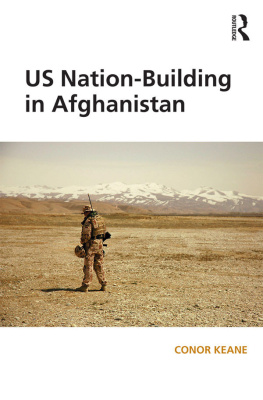A Nuclear Family Vacation: Travels in the World of Atomic Weaponry
(with Sharon Weinberger)
Armed Humanitarians
The Rise of the Nation Builders
NATHAN HODGE

Copyright 2011 by Nathan Hodge
All rights reserved. No part of this book may be used or reproduced in any manner whatsoever without written permission from the publisher except in the case of brief quotations embodied in critical articles or reviews. For information address Bloomsbury USA, 175 Fifth Avenue, New York, NY 10010.
Published by Bloomsbury USA, New York
LIBRARY OF CONGRESS CATALOGING-IN-PUBLICATION DATA
Hodge, Nathan.
Armed humanitarians : the rise of the nation builders / Nathan Hodge. 1st u.s. ed.
p. cm.
Includes bibliographical references.
ISBN: 978-1-60819-017-1 (hc)
1. Humanitarian interventionPolitical aspectsUnited States. 2. Nation-buildingUnited States. 3. United StatesMilitary policy.
I. Title.
JZ6369.H63 2010
355.02'80973dc22
2010025752
First published by Bloomsbury USA in 2011
This e-book edition published in 2011
E-book ISBN: 978-1-60819-445-2
www.bloomsburyusa.com
For Sharon
Contents
The Super Stallion shuddered to a halt, and the flight engineer signaled for me to follow. I stepped from the rear ramp, and hot exhaust from the giant CH-53 helicopter washed over me as I walked across the landing zone. I surrendered my helmet and float coat to the crewman, shouldered my rucksack, and followed my fellow passenger, a Marine Corps lieutenant colonel, to the rear gate of the U.S. embassy, Port-au-Prince.
We picked our way across the landing zone. A few paratroopers of the Eighty-second Airborne Division in soft patrol caps and wraparound shades were guarding the dusty, trash-strewn field. One of the soldiers, sucking impassively on his CamelBak canteen, waved us through to the embassy motor pool. The CH-53 then lifted off, the turbine engines briefly drowning out the jackhammer of the diesel generators inside the compound.
A Winnebago-sized truck with the logo of the Federal Emergency Management Agency was parked behind the high gates, its satellite antenna pointed skyward. Near another outbuilding, military cots were arranged in neat rows, complete with sleeping bags and mosquito netting. Crates of electronic equipment and medical gear were stacked on the gravel. On the inner lawn of the embassy, near a lap pool, was a small encampment where someone had pitched several pup tents, plus a few family-sized shelters. It looked as though someone had raided an outdoors store and dumped the contents on the embassy grounds.
The compound was swarming with uniforms. Some were familiar: Marines in dusty digital-pattern camouflage, Navy personnel in crisp blue utility suits, Army soldiers in combat fatigues. Some were a bit more exotic: Foreign Service officers in Patagonia hiking boots, contractors in 5.11 tactical gear, members of the National Disaster Management Agency in matching blue shirts, khaki cargo pants, and floppy-brimmed hats. Everyone seemed to be moving with brisk purpose.
Just a few weeks earlier, on January 12, 2010, a magnitude 7.0 earthquake had struck Haiti, the poorest country in the Western Hemisphere. The disaster killed over 200,000 Haitians and left the country without a functioning government. Official buildings were demolished, the local police force was paralyzed, and Haitis splendid presidential palace, completed during the U.S. military occupation in the early twentieth century, was left in ruins. The quake also had decapitated MINUSTAH, the United Nations Stabilization Mission in Haiti. Hedi Annabi, the Tunisian diplomat who served as special representative of the Secretary-General and as head of the UN mission, was killed, along with his deputy, Luiz Carlos da Costa of Brazil. Dozens of international peacekeepers, police advisors, and civilian UN staffers died in the collapse of their headquarters.
The seismic shock had knocked out the control tower at Toussaint LOuverture International Airport and collapsed the north pier of the main port, cutting Port-au-Prince off from the outside world. Within hours of the disaster, however, the airport was up and running: A team from the U.S. Air Forces Twenty-third Special Tactics Squadron, 720th Special Tactics Group, had flown in to take over air traffic control so that search-and-rescue teams and medical aid could arrive. Within five days of the disaster, the Air Force had directed over six hundred takeoffs and landings on an airstrip that usually saw fewer than half a dozen flights a day. The place was now crowded with canvas tents that served as an improvised headquarters for flight operations. Reinforcements arrived quickly. Days after the quake, soldiers of the Eighty-second Airborne Divisions First Squadron, Seventy-third Cavalry Regiment began deploying to Haiti. They set up camp at an abandoned country club near the U.S. embassy.
In the weeks following the disaster, the U.S. force in Haiti and off the coast kept growing. Less than a week after the quake, fourteen hundred U.S. troops were on the ground, with another five thousand offshore. By the end of January, just over two weeks after the disaster, the Haiti earthquake relief mission involved twenty thousand U.S. military personnel, twenty-four ships, and more than 120 aircraft. It was an impressive military surge, but the U.S. mission involved an alphabet soup of civilian agencies as well. The U.S. Agency for International Development, or USAID, sent a Disaster Assistance Response Team for an initial assessment, mobilized search-and-rescue teams from around the country, and held emergency planning meetings with private relief groups and aid contractors. USAID, an autonomous federal agency indirectly overseen by the secretary of state, was designated as the lead agency for organizing the U.S. earthquake relief effort. A crisis-response team from the State Departments Office of the Coordinator for Reconstruction and Stabilization was on the scene as well.
The U.S. embassy had become the nerve center for a giant, quasi-military expedition, far removed from the world of traditional diplomacy. Everything here was expeditionary, from the Meals-Ready-to-Eat rations and lukewarm bottled water to the bottled bug spray and droning generators. The embassy looked as though it was preparing for a siege: On the street outside, Marines in camouflage uniforms and boonie hats guarded the main entrance with M16 rifles, 12-gauge shotguns, and M249 light machine guns. A perimeter made of wooden traffic barriers and tape marked off an outer perimeter, while Haitians patiently queued up under the relentless midday sun for emergency visas. The scene represented a curious merger between military force and humanitarian aid, a blurring of the traditional lines of development work, diplomacy, and national defense. This was the new face of American foreign policy: armed humanitarianism.
The 2010 Haiti relief mission was a response to a natural disaster, but the massive military operationand many of its distinct featuresgrew directly out of the experience gained in fighting wars in Iraq and Afghanistan. That spring, as the military began a phased withdrawal from Haiti, Army Major General Simeon Trombitas, the commander of Joint Task ForceHaiti, told me that the humanitarian operation, which placed unprecedented emphasis on openness and information sharing with nongovernmental organizations (NGOs) and civilian relief agencies, had been shaped by the lessons of combat. Due to all of our services experience in Afghanistan and Iraq, and working with the populations there, and with other agencies, weve developed great relationships working with our own other government agencies and NGOs, he said. Here weve fine-tuned that, because they are the ones with the assets that deal directly with the people, and we can enhance what they do.
Next page








